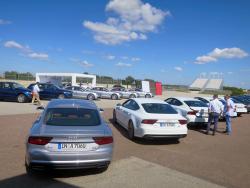 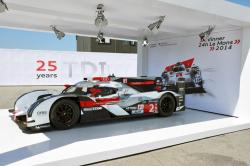 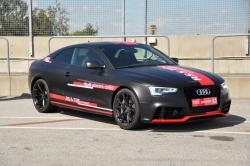 Audi TDI 25th Anniversary, Audi TDI Le Mans racecar, RS 5 TDI Concept. Click image to enlarge |
Article by Paul Williams, photos by Paul Williams and Audi AG
Copenhagen, Denmark – If you’ve ever wondered about the reliability and longevity of diesel engines, you’ve only to visit Copenhagen’s “Diesel House,” a museum/display centre where you’ll find what for 30 years was the world’s largest diesel engine (it’s 12.5 metres tall, 24.5 m long, and weighs 1,400 tons). It now runs only twice a week for demonstration purposes, but it used to run continuously.
Commissioned in 1933, this giant two-stroke, eight-cylinder engine powered the city of Copenhagen for decades, and from the 1970s until 2004 was still in commission as a standby unit. Built by the Burmeister & Wain (B&W) company who signed an exclusive agreement with Rudolf Diesel to build and develop diesel engines in Denmark, it makes 2,800 horsepower per cylinder; 22,400 hp total. The museum also houses a one-cylinder B&W engine delivered in 1904. It, too, still works like a charm.
Fitting, therefore, that Audi would choose Copenhagen as the location to celebrate the 25th anniversary of its Turbo Direct Injected (TDI) diesel engine, of which 7.5 million have been built since 1989. Over that period, the TDI has seen its power and torque relative to displacement increase by over 100 percent, while pollutant emissions have come down by 98 percent. The event in Copenhagen discussed the current state of TDI development and future directions for the technology.
The first TDI offered to consumers was found in the 1989 Audi 100, introduced at the Frankfurt Auto Show and powered by a 2.5-litre, inline five-cylinder engine making 120 hp. According to Jan Helbig, Mechanical Testing, TDI, the engne’s breakthrough technologies were turbocharging and direct injection of fuel into the cylinders, which was controlled by an electronic engine management system. These technologies continue to be the foundation of the TDI engine, although they have, of course, been refined over the years with Audi engineers focusing on using less fuel, making more power and significantly reducing, if not eliminating, emissions.
Currently Audi offers 156 TDI models (total for all markets), and has introduced an “ultra” line, examples of which represent the best fuel economy available to each model series. The Audi A3 ultra, for instance, returns 3.2 L/100 km.
Audi is also working to hybridize its diesel fleet and is planning to introduce plug-in diesel hybrids that can run a minimum of 50 km on battery alone. While moving forward on the electrification of the diesel, Audi continues to work on the more “classic” technology fields to reduce emissions, including friction reduction, thermal management and controlling the combustion process.
“Rightsizing” rather than downsizing is the company’s mantra: selecting the right engine size for the respective size of the car. Audi points out that the six- and eight-cylinder TDI engines, for example, have proven to be highly efficient because they can run smoothly at extremely low engine speeds.
Racing is also a factor in diesel technology development. Audi debuted the TDI engine at Le Mans in 2006 and has taken the chequered flag as overall winner eight times in nine starts since then, most recently in 2014 with a 1-2 finish. “In principle,” says Audi, “the same requirements apply on the racetrack and in production. The goal is to always get more and more out of every drop of fuel.”
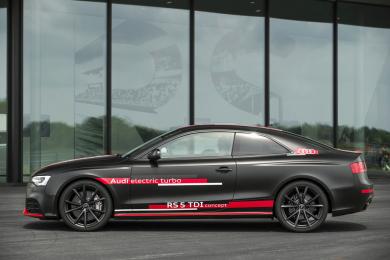 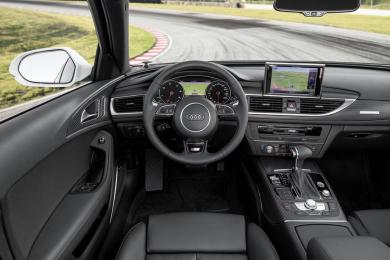 Audi RS 5 TDI Concept, driver’s seat. Click image to enlarge |
As mentioned above, turbocharging, fuel injection and emissions control are the three main drivers of TDI engine development. The turbocharger in the new 3.0 TDI, for instance, uses an electric actuator that adjusts the position of the turbine wheel vanes in increments of less than 200 milliseconds, and manages exhaust gases that reach temperatures of 830 degrees Celsius. This level of precision and control enables engineers to make small refinements that incrementally improve results.
Concerning fuel injection, with most engines Audi already uses peak pressures of 2,000 bar in its common-rail injection system. The pressure and its management are important because they influence the power available per litre of displacement in the engine, along with the smoothness of the engine’s operation. The next target, according to Audi, is 2,500 bar, and they point out that the Audi R18 e-tron quattro race car uses an injection pressure of 2,800 bar to produce 134 horsepower per litre of displacement, demonstrating the feasibility of the goal.
  Audi TDI-equipped engine bay & Next-Generation Audi TDI Diesel Engine. Click image to enlarge |
A related technology involves the piezo injectors that Audi uses, with nozzle holes just 0.1 millimetre in diameter. The tiny nozzles enable the fuel to be finely atomized even at low load, and the high pressure produces a more precise mixture that improves power, torque, smoothness and emissions. Basically, in diesel engine development, the fundamentals are in place; now it’s an ongoing process of improving them.
The common rail system, for instance, can make nine individual injections of fuel as part of the combustion process, each of which is timed and managed electronically to operate at the highest level of efficiency.
The new longitudinally mounted 2.0L TDI is described by Audi as “a true all-rounder.” In global markets it’s found in the A1 through the A6, along with the mid-size Q5 SUV. The new 3.0L TDI increases performance but can return 5.2 L/100 km while producing lower emissions. Enhancing “off the line” acceleration, its maximum torque of 428 lb-ft is available at between 1,250–3,250 rpm propelling the A7 Sportback, for example, from 0–100 km/h in a mere 5.7 seconds.
As mentioned above, the term “Audi Ultra” is used for only the most fuel-efficient of each model series. Audi says it represents, “not just full everyday practicality, but also sustainable mobility.” Currently Audi offers 23 Ultra models, of which 15 are equipped with TDI engines. They offer an average fuel consumption of 3.2–4.9 L/100 km. Audi Ultra models are also expected in Canada, although specifics are not yet available.
  Audi RS 5 TDI Concept. Click image to enlarge |
Along with a focus on fuel economy and low emissions, Audi is following development paths that will make the diesel engine more emotional and sporty. In addition to the standard turbocharger, Audi is working toward production vehicles with an electric bi-turbo system that will significantly improve acceleration from standstill. The addition of an electric compressor effectively “fills the torque hole” that one can experience with conventional turbochargers as they build boost when starting and after changing gears. Using this technology in the Audi RS 5 TDI concept, for example, 0–100 km/h can be attained in “roughly four seconds….”
Audi points out that the strengths of the electric bi-turbo are particularly suited for everyday driving as it makes power more readily available at low engine speeds. It also slashes acceleration times between 60–120 km/h, obviating the need for downshifting. Additionally, Audi suggests, performance-oriented drivers “will appreciate the passing power and immediate delivery of power when exiting a curve.”
The electric compressor, by the way, is largely powered by energy recuperated when coasting so that energy consumption is basically neutral. It’s supplied with power via a 48-volt electrical subsystem with its own lithium-ion battery. Such a system is relevant for power-consuming electrical components and ancillaries of the future, like thermoelectric heating elements, electromechanical rear brakes, along with oil and water pumps. And because a 48-volt system uses less current, smaller cables can be used, reducing weight. It all contributes to fuel efficiency and emissions reduction.
Audi plans to offer the electric bi-turbo in the TDI sector soon, and the 48-volt electrical subsystem to multiple model series shortly.
The TDI engine has come a long way since 1989. Along with current models, Audi brought an example of the 1989 100 TDI to our test location at Malmo, Sweden. One of the first things you notice about that car in operation is what used to be the signature diesel clatter. Over time, the TDI has been tuned and developed to such a degree that it’s now barely audible outside the car and inaudible inside the car except when accelerating briskly.
Audi’s current achievements with diesel engines have certainly made the point that this is an enduring and relevant technology. Not only has Audi smoothed the rough edges and won over millions of consumers, but now it appears diesels in the form of the TDI can be genuinely sustainable and more fun to drive. Even sales in the US market are up (by 13 percent last year). Canadians have never needed much convincing, and it’s good to learn that more TDI options will be available from Audi here in the future.









